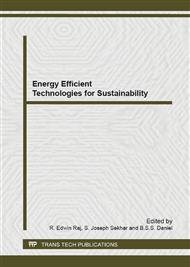[1]
Acero . J, Alonso . R, Burdío . M . J, Barragán . A . L and Puyal . D, Frequency-dependent resistance in litz-wire planar windings for domestic induction heating appliances, IEEE Trans. Power Electron., vol. 21, no. 4, p.856–866, Jul. (2006).
DOI: 10.1109/tpel.2006.876894
Google Scholar
[2]
Acero . J, Alonso . R, Burdío . M . J , and Barragán . A . L , Modeling of planar spiral inductors between two multilayer media for induction heating applications, IEEE Trans. Magn., vol. 42, no. 11, p.3719–3729, Nov. (2006).
DOI: 10.1109/tmag.2006.882308
Google Scholar
[3]
Ahmed . A . N , Bessyo . D , Yasui . K, Omori . H Terai . H , and Nakaoka . M , The inverter circuit skills to realize low-cost, compact-size power supply for microwave oven, and the advantages of improved defrosting, in Proc. IAS Int. Appl. Tech. Conf., Apr. 2000, [CD ROM].
Google Scholar
[4]
Burdío . M . J, Monterde . F , García . R . J , Barragán . A . L, and Martínez . A , A two-output series-resonant inverter for induction-heating cooking appliances, IEEE Trans. Power Electron., vol. 20, no. 4, p.815–822, Jul. (2005).
DOI: 10.1109/tpel.2005.850925
Google Scholar
[5]
Fujita . H, Akagi . H, Sano . K, Mita . K, and Leonard . H . R, Pulse density modulation based power control of a 4 kW 400 kHz voltage-source inverter for induction heating applications, in Proc. IEEJ PCC, Yokohama, Japan, 1993, p.111–116.
DOI: 10.1109/pccon.1993.264238
Google Scholar
[6]
Hishikawa . S, Serguei . M, Nakaoka . M, Hirota . I, Omori . H and Terai . H, New circuit topology of soft switching single-ended high frequency inverter using IGBTs, IEICE-J Energy Electron. Prof. Meeting, vol. 100, no. 628, p.19–24, Feb. (2000).
DOI: 10.1109/pesc.2001.954443
Google Scholar
[7]
Kaneda . M , Tanaka . H , and Nakaoka . M , A novel prototype of single-ended push-pull soft- switching high-frequency inverter using a single auxiliary ZVS-PWM switch, IEICE-J. Energy Electron. Prof. Meeting, vol. 100, no. 628, p.31–37, Feb. (2000).
Google Scholar
[8]
Kifune . H, Hatanaka . Y and Nakaoka . M , Cost effective phase shifted pulse modulation soft switching high frequency inverter for induction heating applications, Proc. Inst. Elect. Eng. , vol. 151, no. 1, p.19–25, Jan. (2004).
DOI: 10.1049/ip-epa:20040085
Google Scholar
[9]
Muraoka . H, Nakaoka . M , and Sakamoto . K , High-frequency PWM forward converter with auxiliary active clamped capacitor for low voltage high current operation, in Proc. IEEE Power Electron. Spec. Conf., Vancouver, Canada, Jul. 2001, vol. 3, p.1523.
DOI: 10.1109/pesc.2001.954335
Google Scholar
[10]
J. R. Garcia, J. M. Burdio, A. Martinez, and J. Sancho, A method for calculating the workpiece power dissipation in induction heating process, in Proc. Appl. Power Electron. Conf. Expo., 1994, vol. 1, p.302–307.
DOI: 10.1109/apec.1994.316384
Google Scholar
[11]
L. R. Egan and E. P. Furlani, A computer simulation of an induction heating system, IEEE Trans. Magn., vol. 21, no. 5, p.4343–4353, Sep. (1991).
DOI: 10.1109/20.105060
Google Scholar


